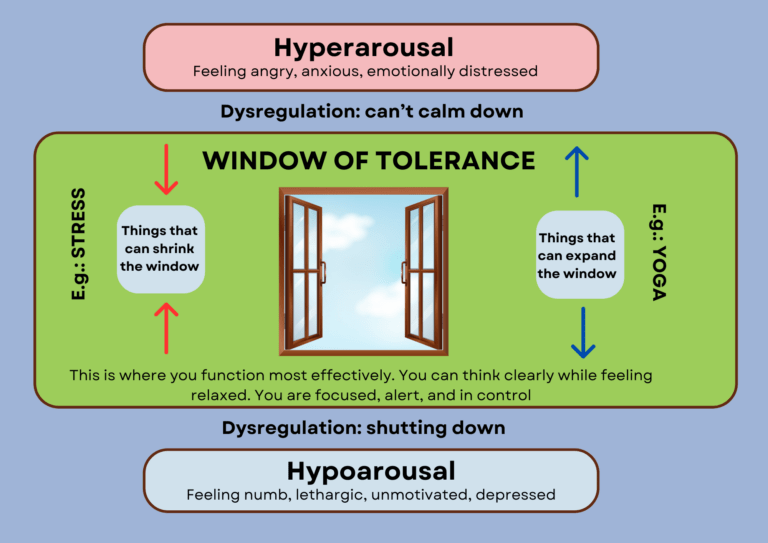How to Build Stress Resilience with Yoga

In today’s fast-paced world, stress has become an unavoidable part of our lives. High demands of modern living can take a toll on our mental and physical well-being. In this blog post, we’ll discuss how yoga can be a powerful tool for building stress resilience. But before delving into the topic, let’s understand some key concepts.
Stress and Homeostasis
Stress is the body’s natural response to physical, psychological, or emotional strain. It can be categorized into:
- Acute stress: Short-term stress which often results from immediate stressors like deadlines or traffic jams.
- Chronic stress: Stress that persists over an extended period. It is often caused by ongoing situations like financial difficulties or relationship problems.
In biological terms, stress disrupts homeostasis. Homeostasis is the body’s way of keeping its internal environment stable for survival. It operates on the micro (cell and tissue) and macro (entire body) level. Yet, when a stressor persists or intensifies over time, it may deplete the body’s resources.
Stress and Resilience
Although often viewed negatively, the acute stress response is crucial. It enables us to react and adapt to our environment. Thus, it ensures our readiness to tackle challenges for survival.
When we encounter stress, our bodies initiate the “fight or flight” response. They release hormones like cortisol and adrenaline to prepare us for action. This response mobilizes energy sources and refines coping strategies. It also boosts cognitive functions to enable learning from experiences. Thus, a healthy stress response is “good stress”. It’s foundational for developing resilience against future stressors of similar nature.
Having said all that, we can define stress resilience as follow:
Stress resilience is the capacity to rebound from stress, preserving mental and physical well-being.
However, when stress surpasses an individual’s ability to cope, it can cause harm. This means it can perpetuate the healthy stress response. Chronic stress triggers heightened production of stress hormones. This can compromise the immune system and pave the way for mental and physical health issues.
Resilience and Neuroplasticity
Our brains have an incredible ability to reorganize and form new neural connections throughout our lives. This ability is called neuroplasticity. Thanks to neuroplasticity, our brains can adapt and change when faced with stress. It means we can make our brains more resilient with intention.
It’s important to be aware of our mental and emotional states throughout the day. Sometimes we may feel anxious or agitated (hyperarousal), while other times we may feel numb or depressed (hypoarousal). Both states are reactions to stress. Our goal is to stay in our “window of tolerance,” where we can handle our emotions and think clearly. This is the sweet spot between feeling too overwhelmed and feeling shut down.

Yoga and Stress Resilience
Yoga offers a holistic approach to stress management and building resilience. It offers a set of tools and techniques to regulate our nervous system. With yoga, we can expand our “window of tolerance”. Here are some ideas.
Mindfulness Meditation
Mindfulness is characterized by paying attention to the present moment without judgment. Meditation techniques help observe our thoughts and emotions without becoming entangled in them. Regular mindfulness meditation can cause changes in the brain’s structure and function. These changes often mean less activity in the amygdala, a part of the brain linked to fear responses. At the same time, they increase activity in the prefrontal cortex. This part of the brain is responsible for cognitive control and emotional regulation.
Additionally, regular meditation practice can lower levels of stress hormones such as cortisol. It can also reduce sympathetic nervous system activity. Both lead to a more balanced physiological response to stressors.
Restorative Yoga
Restorative yoga, unlike more active practices, emphasizes deep relaxation and surrender. Using props such as blocks and bolsters, it encourages the release of tension from the body and mind. Restorative yoga stimulates the parasympathetic nervous system, promoting profound relaxation. Thus, it counteracts the negative impacts of chronic stress on physical and mental well-being.
Physical Asana Practice
The physical asana practice, like any exercise, activates the sympathetic nervous system. This triggers a coordinated response in the body to preserve homeostasis. It boosts heart rate, blood pressure, and airway dilation. All is necessary to meet increased demands on physical, respiratory, and cardiovascular functions.
Exercise in general has significant effects on neuroplasticity. It stimulates neurogenesis, the process of generating new neurons, particularly in the hippocampus. Hippocampus is a brain region critical for learning and memory. These neurons can contribute to cognitive function and emotional regulation.
Exercise also has mood-enhancing effects and can reduce stress and anxiety levels. Elevated stress hormones such as cortisol can negatively impact neuroplasticity. It also influences the release and interaction of various hormones in our brain.
Dopamine
Dopamine is often hailed as the “reward neurotransmitter”. It’s linked with feelings of pleasure and motivation. Engaging in exercise prompts the release of dopamine, generating a sense of contentment. This reinforces the habit of regular physical activity and facilitates stress relief. By delivering dopamine-driven rewards, exercise encourages adherence to fitness routines. In its turn, this cultivates long-term resilience against stress.
Endorphins
Endorphins earn their title as “feel-good” chemicals for a good reason. When we engage in physical activity, endorphins flood our system. They bind to certain receptors in the brain, leading to feelings of euphoria. At the same time, they dull sensations of pain. Not only does it help to combat stress but also to reduce anxiety and uplift mood.
Serotonin
Another crucial component in the stress-reduction toolkit is serotonin. It plays a pivotal role in regulating our mood and emotions. Physical exercise boosts serotonin production, fostering a sense of tranquility. Regular physical activity can have a positive effect on serotonin levels. This may reduce the risk of depression and anxiety.
Conclusion

Are you interested in yoga, fitness, and personal development? So am I! Are you trying to juggle parenthood and work? Me too! In my blog, I write about all these topics (and more!) as I want to help working parents find energy, strength, and balance in life.

